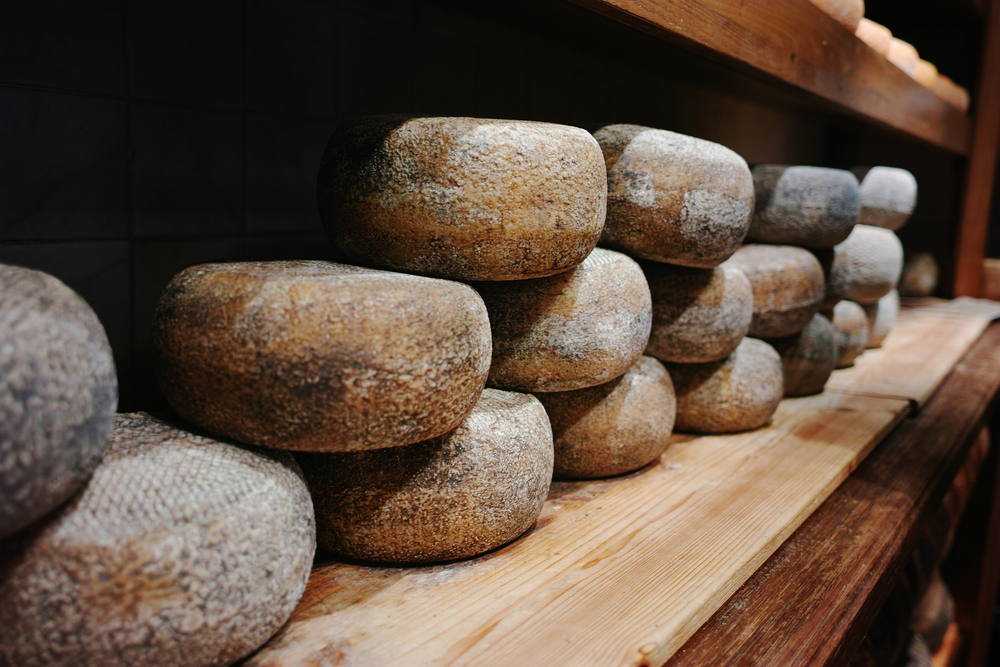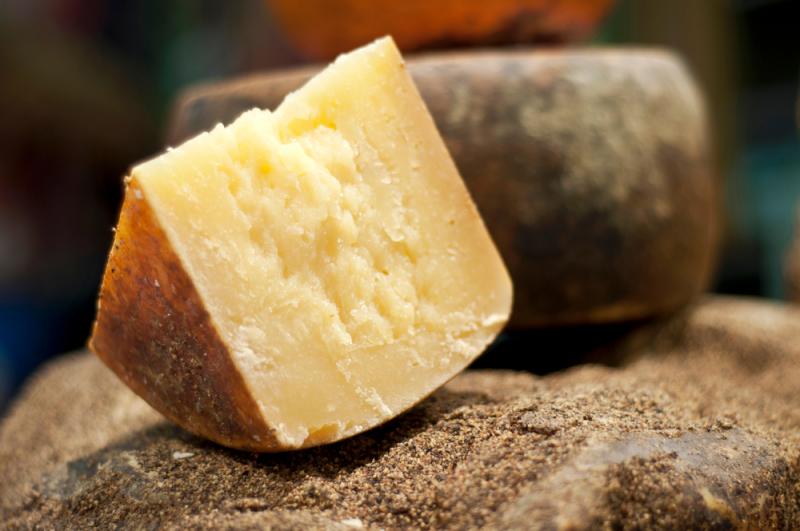Soft, hard and somewhere in between, the types of pecorino are innumerable and produced in nearly every region of Italy. They’re aged in caves and with cherries and chili peppers, but all have one feature in common — ewes.
Pecorino comes from the Italian word for sheep, pecora, which grazed freely in today’s Lazio where the cheese was first fermented in ancient Rome. The most well-known type of pecorino is Pecorino Romano, which since the 1990s has had a European Union DOP (protected designation of origin) status to define where the cheese is produced. But even if its roots are Roman, today’s Pecorino Romano is overwhelmingly made in Sardinia.
No matter where in Italy it’s made, to qualify as pecorino, the cheese needs to be from the milk of grass-fed ewes. The flavors of herbs the sheep eat in the wild — such as thyme — can come through in the cheese’s flavor, while the period of aging and what it’s aged with (adding vinegar, olive oil or salt) also contributes to the taste. A pecorino can be as young as 20 days or as old as two years when you slice it for that first bite. The cheese you select all depends on how you’ll eat it.
Italy Magazine’s Buyer’s Guide to Pecorino explains what type of pecorino to take home for different occasions, so you'll know which pecorino to grate on your pasta or for authentic cacio e pepe (spoiler: it’s Pecorino Romano). But what makes a pecorino from Lazio different from a pecorino from Sardinia or Tuscany? This pecorino road map will get you in the mood for your next culinary adventure, helping you decide which cheese to try on your next trip, or which one to buy online to taste Italy from anywhere in the world.
Lazio and Pecorino Romano

Pecorino Romano is the ingredient that you need for an authentic plate of cacio e pepe or spaghetti alla carbonara, which are both associated with the Eternal City. A fully stagionato (aged) cheese, it's processed between five months to a year, giving the end product a salty taste and grainy texture that's ideal for grating — the longer it's aged, the saltier it becomes. Before you even cut into it, you can recognize a Pecorino Romano by its appearance with a thin white or yellow-ish rind that is typically stamped with Pecorino Romano and a sheep’s head.
Pecorino Romano DOP is a staple in many Italian home kitchens (often kept in a paper bag in the refrigerator to extend its shelf life); more than 32,000 tons of of the stuff were produced in Italy during the 2021-2022 season. Pecorino Romano from Lazio made up about 6% of that number, or 1,987 tons. But that’s no comparison to Sardinia, which produced more than 90% of Italy’s Pecorino Romano DOP or about 30,000 tons. Production specifications for Pecorino Romano DOP state that it can only be produced in Sardinia, Lazio, and portions of the Tuscan province of Grosseto. The cheese’s milk enzymes and rennet must also be indigenous to the area where it’s produced for it to have DOP status.
Sardinia, Pecorino Sardo and Primosale
In Sardinia, there’s a steady supply of Pecorino Romano, but it also has Pecorinos with roots on the island south of Corsica. As the Blue Zone has publicized, Pecorino Sardo is rich in Omega-3 fatty acids from its grass-fed sheep. Pecorino Sardo also has a DOP and comes in two varieties — dolce and maturo.
Pecorino Sardo Dolce is aged from 20 to 60 days, with a soft, hole-filled texture, and often has herb notes such as thyme and lemon, depending on the grass its sheep grazed on. It pairs well with sweets, especially the Pecorino Primosale variety that’s aged for about one month, is a bit damp, and is bright white. The Sardinian dessert, seadas, are deep-fried pockets of dough filled with Primosale and covered in honey (chestnut honey is preferred for the best flavor profile). Pecorino Sardo Maturo is aged for a minimum of two months, giving it a hard rind and a spicy taste and it can be served either grated or as part of an antipasto with cured meats.
Tuscany and Cave Pecorino

In Tuscany, .34% of Italy’s Pecorino Romano is produced but other types of Pecorino are aged in the dark, quiet, humid environment of caves. The cheese will stay inside the cave for up to a year as it's monitored, turned, and rubbed with olive oil, allowing the cheese to form a thick mold layer — like a Pecorino Riserva from Montepulciano, known for its earthy flavor.
In Pienza and the entire Val d’Orcia region, Pecorino stagionato often has a black rind and is aged for two to five months, while semi-stagionato often has a red rind from a tomato juice coating and a soft texture from its aging of at least 30 days. In Pienza, you’ll also find cheeses wrapped in walnut leaves and aged in terracotta jars.
Though Pecorino Romano may take the spotlight, there’s no end to the types of Pecorino that you can taste, both following traditional methods and the creative flavor combinations of cheesemakers.
Ready to add your preferred pecorino to your pantry? Dolceterra has a wide selection of pecorino that can be shipped nearly anywhere in the world.
About Dolceterra
Dolceterra transports the authentic Italian culinary experience directly to your doorstep, delivering the Italian dolce vita across the United States and the rest of the world. The founders are Italian, dedicated to carefully selecting the best artisanal gourmet products from every region, including pasta, cheese, and extra virgin olive oil, with a focus on quality and attention to detail.













